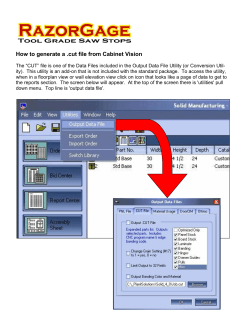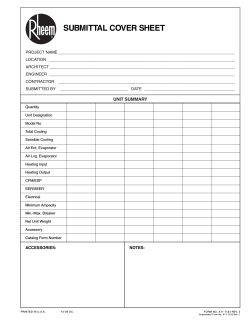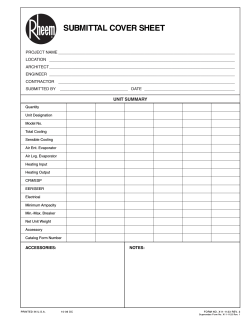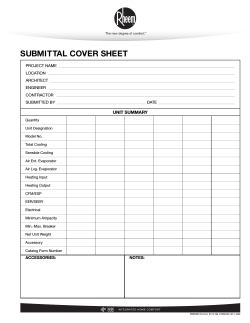
Undercounter Laboratory & Pharmacy Refrigerators - Nor
UNDERCOUNTER LABORATORY REFRIGERATORS and FREEZERS Installation, Operation and Maintenance Instructions ________________________________________________________________________ INSPECTION When the equipment is received, all items should be carefully checked against the bill of lading to insure all crates and cartons have been received. All units should be inspected for concealed damage by uncrating the units immediately. If any damage is found, it should be reported to the carrier at once, and a claim should be filed with the carrier. This equipment has been inspected and tested in the manufacturing facility and has been crated in accordance with transportation rules and guidelines. Manufacturer is not responsible for freight loss or damage. INSTALLATION GENERAL After the unit crate and base have been removed, locate the legs or casters found (if applicable) in the interior of the cabinet. Attach the legs or casters to the unit base by screwing them into the same threaded fittings that were used to secure the crate base to the cabinet. Insure that they are screwed all the way into the base. If for some reason the doors are not squared up on the cabinet, the doors can be adjusted. Opening the door(s) and loosening the screws that hold both the top and bottom hinges to the cabinet can accomplish this. After adjusting the door so that it is aligned correctly, tighten the screws to securely hold the hinges in place. LOCATION The refrigeration system located at the bottom of the cabinet requires free air access for proper operation. Important: The cabinet may be enclosed on two sides, however, there must be a minimum four inch clearance from the back of the cabinet to a wall, and from the bottom of the cabinet to the floor. This model cannot be operated without the legs or casters in place, and the bottom of the cabinet cannot be enclosed. The cabinet should be level when it is placed in its permanent location. Ambient conditions must range between +59° to +90°F (+15° to +32°C). Confirm the door seal is sealing on all 4 sides. The door seal integrity is critical to the cabinets operation, improper door seal can result in quicker frost build up, longer comp runtime, and proper temperature uniformity. 1 04/15 Rev. C 110195 ELECTRICAL Check the proposed outlet to be used to insure that the voltage, phase, and current carrying capacity of the circuit from the electrical panel correspond to the requirements of the cabinet. Never use an extension cord. All inter wiring between the electrical panel and the unit must be done in accordance with the National Electric Code and all state and local codes. See the Serial Tag for all pertinent electrical information. OPERATION REFRIGERATORS FORCED AIR MODELS (Auto Defrost) The forced air under counter refrigerators employ a unit cooler evaporator located inside the cabinet as the heat-removing source. Through the refrigeration process, heat is captured in the evaporator, transferred to the condensing unit located at the bottom of the cabinet, and expelled to the surrounding outside air. It is extremely important to maintain the minimum fourinch clearance as described in this manual under "Location" for the refrigeration process to function properly. The cabinet cannot be operated without the legs or casters installed. During the operation of these units, frost will periodically form on the coil surface. Each time the refrigeration compressor cycles to the "off" position, the evaporator fans and condenser fans will continue to run. This will tend to keep the interior of the cabinet at a constant temperature and at the same time remove any frost build up on the unit by circulating the inside air over the coil. The water produced will collect in the unit cooler drain pan and travel down a drain tube to the condenser drain pan where the water will vaporize back into the air. COLD WALL MODELS (Manual Defrost) Some of the under counter refrigerators are available in a cold wall version. The cold wall models employ evaporator tubing embedded in the sidewalls and back of the unit. During the refrigeration process, heat is removed through the evaporator tubing and expelled through the condensing unit. With this type of design, condensation may form on the interior of the cabinet and should be periodically wiped dry. In order to assure proper airflow, make certain the flow of air behind the cabinet and through the front louver is not restricted. The refrigeration system on this cabinet uses a temperature thermostat that senses the cut in and cut out temperatures of the cold wall evaporator coil. The temperature can be adjusted by turning the thermostat control knob that is located behind the lower front panel. 2 04/15 Rev. C 110195 FREEZERS FORCED AIR UNIT COOLER MODELS The forced air under counter freezers employ a unit cooler evaporator located inside the cabinet as the heat removing source. Through the refrigeration process, heat is captured in the evaporator, transferred to the condensing unit located at the bottom of the cabinet, and expelled to the surrounding outside air. It is extremely important to maintain the minimum fourinch clearance as described in this manual under "Location" for the refrigeration process to function properly. The cabinet cannot be operated without the legs or casters installed. After shutting the door on these freezer models, a short amount of time must be allowed before the door can be reopened. This is due to the tight seal maintained between the door and the cabinet. Waiting a few moments for the pressure to equalize permits the door to be opened easily. A positive defrost is required to remove frost from the coil. This is accomplished by energizing heaters positioned on the coil surface. The temperature control is factory set to allow four defrosts per day. Note: Setting the correct time of day will be required to maintain these defrost periods. When the preset defrost time is reached, the control automatically terminates the refrigeration process by turning off the condensing unit and unit cooler fan motors, and energizes the defrost heaters. As the coil temperature increases, the frost begins to melt producing water that runs down the coil to the unit cooler drain pan and exits through the drain tube to the vaporizer. After all the frost has been removed and the coil temperature reaches approximately +10°C, (The internal temperature of the cabinet will rise slightly during the defrost cycle) the defrost is terminated through the action of the defrost termination control located on the unit cooler, and the refrigeration process resumes. In order to insure that any excess water remaining on the coil is not sprayed into the cabinet interior, and all heat generated by the defrost is removed, the unit cooler fans will not operate until the coil temperature reaches approximately -4°C. COLD WALL MODELS The cold wall freezer models employ evaporator tubing embedded in the sidewalls, back, and top of the unit. During the refrigeration process, heat is removed through the evaporator tubing and expelled through the condensing unit. Because of the cold wall design, it will be necessary to occasionally manually defrost the freezer models. First, remove all the contents and relocate to another freezer. Next, unplug the unit and open the door. Wipe the cabinet dry when defrosting is complete. Caution: Never use a sharp object to remove the frost build-up. 3 04/15 Rev. C 110195 MICROPROCESSOR CONTROL FEATURES (Auto Defrost Models) The temperature control is located behind the lower front panel. 1. Main temperature display: During normal operations displays cabinet temperature. LED DISPLAYS Each LED function is described in the following table. 4 04/15 Rev. C 110195 FUNCTIONS HOW TO SEE THE SETPOINT 1. Push and immediately release the SET key: the display will show the Set point value. 2. Push and immediately release the SET key or wait for 5 seconds to display the probe value again. HOW TO CHANGE THE SETPOINT 1. Push the SET key for more than 2 seconds to change the set point valve; 2. The value of the set point will be displayed and the “˚C” or “˚F” LED starts blinking. 3. To change the Set value push the UP or DOWN arrows with in 10 seconds. 4. To memorize the new set point value push the SET key again or wait 10 seconds. HOW TO START A MANUAL DEFROST 1. Push the DEF key for more than 2 seconds and a manual defrost will start. HOW TO SET ALARMS 1. Enter the programming mode by pressing the SET + V (down) KEYS FOR 3’s (the “C” of “F” LED starts blinking) 2. Press set key to desired parameter “ALU” and “ALL”. Press set again to see alarm set point. 3. Use “up” and “down” arrow keys to change value. 4. Press set to store the value and move to the following parameter. HOW TO CHANGE A PARAMETER VALUE To change the parameter’s value, operate as follows: 1. Enter the Programming mode by pressing the Set + V (down) keys for 3s (the “°C” or “°F” LED starts blinking). 2. Select the required parameter. Press the “SET” key to display its value 3. Use “UP” or “DOWN” to change its value. 4. Press “SET” to store the new value and move to the following parameter. To exit: Press SET + UP or wait 15s without pressing a key. NOTE: the set value is stored even when the procedure is exited by waiting the time-out to expire. 5 04/15 Rev. C 110195 CONTROL CONFIGURATIONS AND DEFAULT SETTINGS (set-points shown are for reference only) Label Set ALU ALL ALd dAO i1F did dP2 dP3 dP4 Parameter Minimum to Maximum Ranges LS to Set Point US Set point to MAXIMUM Temperature Alarm 230°F 110° C -58°F to Set MINIMUM Temperature Alarm point -50° C Temperature Alarm 0 to 255 Delay minutes 0 to 23hr 50 Delay of temperature alarm at start up min Digital input EL = external Alarm / bL = lock configuration regulation dr = door switch/ dF = defrost 0 to 255 Digital input delay minutes Evaporator probe display -Third probe display Fourth probe display Set Points ? 110 -50 15 1.3 dor 15 nu nu nu GLYCERIN WELL INSTALLATION: 1. Locate the glycerin vessel shipped loose in packaging, Clip glycerin well in clip provided at factory installed location. 2. Add glycerin to glycerin vessel, column should be a minimum of half full. (glycerin provided with packaged materials in side of cabinet.) 3. Insert product sensor as shown above. 6 04/15 Rev. C 110195 Calibrating adjustment: 1. Run the refrigerator/freezer at a continuous set-point for 2 hours (adjust temperature control to desired set-point). 2. Measure cabinet glycerin with a factory calibrated microprocessor temperature monitor. 3. Calibrate glycerin temperature sensor if required by pressing and holding buttons for 5 seconds, #1 (left) or #2 (right) buttons on controller. Optional Chart Recorders: Set –up and operation 1. Open the recorder door and connect the 9 volt battery. This provides battery back-up power to the recorder upon power failure. 2. Provide AC power to the chart recorder 3. Install chart paper 4. Locate the pressure sensitive buttons in the upper left corner, press the change chart button (3) for 1 second , pen will move off the scale. 5. Unscrew center nut, center the paper over the threaded post. Carefully align the day and time with the reference mark (small groove on left side of panel) 6. Replace the center nut, hand tight, press the change button again to begin temperature recording. MAINTENANCE PERIODIC CLEANING Observe all Warning Labels. Disconnect power supply to eliminate electrical shock and injury from moving parts when servicing equipment. Beginning with the initial installation, the interior surfaces of the cabinet should be periodically wiped down with a solution of warm water and baking soda. This solution will remove any odors from spillage that may have occurred. The exterior of the cabinet should also be cleaned frequently with a commercial grade of glass cleaner. Caution: Never use an abrasive or alkaline solution to clean these units. Wipe dry after cleaning. Important: Monthly cleaning of the condenser coil located at the bottom of the cabinet should be done. This cleaning will aid the heat transfer characteristics of the refrigeration system and increase its efficiency. Dust, dirt, and lint will tend to accumulate on the fins of the condensing unit. This obstruction will affect the flow of air through the condenser, thereby lowering the efficiency of the system. A wire brush or a brush with stiff bristles can be used to loosen these particles that are attached to the fins so that they may be removed with a vacuum cleaner. Failure to keep the condenser coil clean and clear of obstructions could result in temperature loss and damage to the compressor. These units are equipped with a vaporizer pan that is located in the rear base of the cabinet and can be accessed from the back of the cabinet. The pan should be cleaned routinely to prevent mold or bacteria buildup. To clean the pan, remove the two hex head screws from the bracket holding the pan in place. Carefully remove the pan, taking care not to break the drain tube going into the pan. Remove any water and particles that may be in the pan. Clean thoroughly. Return the pan to its position, making sure the drain tube is properly placed in the pan. Reattach the bracket. All moving parts have been permanently lubricated and will generally require no maintenance. 7 04/15 Rev. C 110195 MAINTENANCE SERVICE AND ANALYSIS GUIDE REFRIGERATION SYSTEMS - ALL MODELS MALFUNCTION Compressor will not start - no hum Compressor starts and runs, but short cycles on overload protector Compressor will not start hums but trips on overload protector POSSIBLE CAUSE 1. 2. 3. 4. 5. 1. 2. 3. 4. 1. 2. 3. 4. Unplugged or power off Fuse blown or removed Overload tripped Control stuck open Wiring incorrect Improperly wired Low voltage to unit Starting capacitor defective Relay failing to close Low voltage to unit Overload defective Excessive head pressure Compressor hot -- warm ambient SOLUTION 1. 2. 3. 4. 5. 1. 2. 3. 1. 1. 2. 3. 4. Compressor operates long or continuously 1. 2. 3. 4. 5. 1. 2. 3. 4. 5. 1. 2. 3. 1. 2. 1. 2. 3. 4. 5. 6. 7. Short of refrigerant Control contact stuck Evaporator coil iced Restriction in refrigeration system Dirty condenser Overload protector Cold control Overcharge Air in system Undercharge Relay contacts stuck Low voltage to unit Improper relay Incorrect relay Voltage too high or too low Control setting too high Refrigerant overcharge Dirty condenser Evaporator coil iced Not operating Air flow to condenser or Warm ambient conditions Standard temperature system freezes the product Objectionable noise 1. 2. 1. 2. 3. 4. 5. 6. Control setting is too low Control points stuck Fan blade hitting fan shroud Tubing rattle Vibrating fan blade Condenser fan motor rattles General vibration Worn fan motor bearings Water overflowing from evaporator drain pan or condensate vaporizer pan 1. 2. 3. 4. Air leak between Capsule Pak™ Drain line from evaporator drain Drain line from evaporator drain Walk-in operating in high humidity Compressor runs fine, but short cycles Starting capacitor open, shorted or blown Relay defective or burned out Refrigerated space too warm 1. 2. 3. 4. 5. 1. 2. 3. 4. 5. 1. 2. 3. 1. 2. 1. 2. 3. 4. 5. 6. 7. 1. 2. 1. 2. 3. 4. 5. 6. 1. 2. 3. 7. 8 Plug in service cord or turn on power Replace fuse Determine reasons and correct Repair or replace Check wiring against the diagram Check wiring against the diagram Determine reason and correct Determine reason and replace Determine reason, correct or replace Determine reason and correct Check current, replace overload protector Check ventilation or restriction in refrigeration system Check refrigerant charge, fix leak if conditions necessary Fix leak, add charge Repair or replace Determine cause, defrost manually Determine location and remove restriction Clean condenser Check wiring diagram Differential too close – widen Reduce charge Purge and recharge Fix leak, add refrigerant Clean contacts or replace relay Determine reason and correct Replace Check and replace Determine reason and correct Reset control Purge refrigerant Clean condenser Determine reason and defrost Determine reason, replace if necessary Remove obstruction for free air flow – no evaporator blocked storage on top of walk-in Ambient conditions should be 90° or less Reset the control Replace the control Reform or cut away small section of shroud Locate and reform Replace fan blade Check motor bracket mounting, tighten Compressor suspension bolts not loosened on applicable models - loosen them Replace fan motor Check that Capsule Pak™ is properly set and walk-in panel. in panel opening. Clean blockage from inside of drain line pan to condensate vaporizer is blocked with foreign material. Check that drain line heater (on freezers) pan to condensate vaporizer is working and repair or replace as required blocked with ice. 4. Plumb drain line from evaporator to floor environment (heavy door usage). drain or replace hot gas vaporizer with electric vaporizer. Consult factory for further information. 04/15 Rev. C 110195
© Copyright 2025









